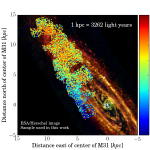W. M. Keck Observatory press release…

The structure and internal motions of the stellar disk of a spiral galaxy hold important keys to understanding the galaxy’s formation history. The Andromeda galaxy, also called M31, is the closest spiral galaxy to the Milky Way and the largest in the local group of galaxies.
“In the Andromeda galaxy we have the unique combination of a global yet detailed view of a galaxy similar to our own. We have lots of detail in our own Milky Way, but not the global, external perspective,” said Puragra Guhathakurta, professor of astronomy and astrophysics at the University of California, Santa Cruz.
The new study, led by UC Santa Cruz graduate student Claire Dorman and Guhathakurta, combined data from two large surveys of stars in Andromeda conducted at the Keck Observatory in Hawaii as well as data from the Hubble Space Telescope.
The Spectroscopic and Photometric Landscape of Andromeda’s Stellar Halo (SPLASH) survey used data from the 10-meter Keck II telescope, fitted with the DEIMOS multi-object spectrograph to measure radial velocities of more than 10,000 individual bright stars in Andromeda.
“The sheer light-gathering power of the Keck Observatory, the superb quality of DEIMOS spectra, free of instrumental/atmospheric artifacts, and its ability to obtain spectra of as many as 300 stars at once were crucial to the success of this experiment,” said Guhathakurta. “The Andromeda galaxy is about 2.5 million light years away so even its most luminous stars generally appear quite faint from our vantage point. To measure precise stellar velocities, the white light of each of these faint stars must be subdivided into thousands of wavelengths. The Keck/DEIMOS combination is the only one in the world capable of making these velocity measurements for large numbers of Andromeda stars.”
The recently completed Panchromatic Hubble Andromeda Treasury (PHAT) survey provided high-resolution imaging at six different wavelengths for more than half of these stars, Dorman said. The study presents the velocity dispersion of young, intermediate-age, and old stars in the disk of Andromeda, the first such measurement in another galaxy.
Dorman’s analysis revealed a clear trend related to stellar age, with the youngest stars showing relatively ordered rotational motion around the center of the Andromeda galaxy, while older stars displayed much more disordered motion. Stars in a “well ordered” population are all moving coherently, with nearly the same velocity, whereas stars in a disordered population have a wider range of velocities, implying a greater spatial dispersion.
“If you could look at the disk edge-on, the stars in the well-ordered, coherent population would lie in a very thin plane, whereas the stars in the disordered population would form a much puffier layer,” Dorman explained.

An alternate scenario involves the formation of the stellar disk from an initially thick, clumpy disk of gas that gradually settled. The oldest stars would then have formed while the gas disk was still in a puffed up and disordered configuration. Over time, the gas disk would have settled into a thinner configuration with more ordered motion, and the youngest stars would then have formed with the disk in that ordered configuration.
According to Dorman, a combination of these mechanisms could account for the team’s observations. “Our findings should motivate theorists to carry out more detailed computer simulations of these scenarios,” she said.
The comparison to the Milky Way revealed substantial differences suggesting that Andromeda has had a more violent accretion history in the recent past. “Even the most well ordered Andromeda stars are not as well ordered as the stars in the Milky Way’s disk,” Dorman said.
In the currently favored “Lambda Cold Dark Matter” paradigm of structure formation in the universe, large galaxies such as Andromeda and the Milky Way are thought to have grown by cannibalizing smaller satellite galaxies and accreting their stars and gas. Cosmologists predict that 70 percent of disks the size of Andromeda’s and the Milky Way’s should have interacted with at least one sizable satellite in the last 10,000 years. The Milky Way’s disk is much too orderly for that to have happened, whereas Andromeda’s disk fits the prediction much better.
“In this context, the motion of the stars in Andromeda’s disk is more normal, and the Milky Way may simply be an outlier with an unusually quiescent accretion history,” Guhathakurta said.
Other researchers who collaborated with Dorman and Guhathakurta on this study include Anil Seth at the University of Utah; Daniel Weisz, Julianne Dalcanton, Alexia Lewis, and Benjamin Williams at the University of Washington; Karoline Gilbert at the Space Telescope Science Institute; Evan Skillman at the University of Minnesota; Eric Bell at the University of Michigan; and Katherine Hamren and Elisa Toloba at UC Santa Cruz. This research was funded by the National Science Foundation and NASA.

